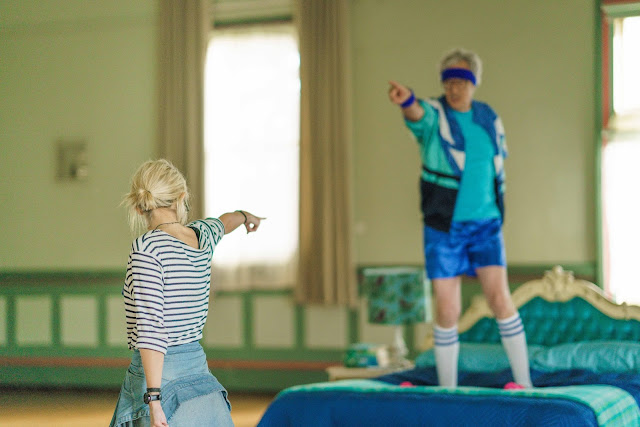Director: Beaufort (Aust)
Video: Muscles 'Girls go crazy'
Q. What inspired you on your idea for the video?
Zorana Adzic. She is a Serb I met in Tokyo. She plays Ultra, the girl at the start and end with 'U' on her purple shirt. Some girls go out every night and party in a nihilistic way, but Zorana does it with a pure, genuine joy that's simply infectious and life-giving. I knew with her as an anchor we could put together a group of girls and send them out on the town and have fun exploring that contradiction of wildness/ vulnerability that Muscles sings about. The 7 girls were based on the 7 deadly sins, wore the 7 colours of the rainbow and had names beginning with the 7 letters of Muscles. Of course, things changed slightly as the story changed.
Q. How were you approached for the job?
I guess Beaufort was on Modular's radar because we did a Bag Raiders clip years ago and they sent through an invitation to pitch.
Q. What were the limitations you faced with the production?
We couldn't find large pancakes upon wrapping shooting, only small ones at Denny's. Film-making is all about compromise.
Q. Who were your key collaborators?
Zorana and the girls were of course the lifeblood. Toshio Hanaoka was my producer, there from the start, then Ivan Hugo the photographer, Ryoma Kotari who helped me film the fireworks in Asakusa and Azuna Saito who did costumes. And Muscles, too, who had many suggestions and ideas. Oh and my agency, Team/Evviva, which is where most of the girls came from.
Q. Had you worked with your crew previously?
I'd only worked before with Toshio, my producer. He played the models' manager in my feature film Tiger which I shot in Tokyo the year before. But myself and Zorana shot some video during cherry blossom season a few years ago which was gold.
Q. What did you shoot on?
We shot on 2 x 5D's. Used a zoom lens and a 35mm I think. And a horrific Zacuto shoulder rig that fell apart almost instantly.
Q. What was the process you took for producing the video?
To describe it in detail would be tedious - but most of the time was spent in pre-production cycling round Tokyo location-hunting. I was searching for a specific bay area for Muscles to come out of the water at the end, like a small, mysterious Godzilla-man. I had seen it in a dream one night, months earlier, but I never found it, so we used Odaiba Beach. Actually I was in Seoul soon after and I think I spied it out a train window, perhaps along the Han River.
Q. Would you call your film an act of guerrilla filmmaking? Or did you seek permits and approvals regarding your locations?
We only had permission to shoot in the club. On the whole, I think it's easier to shoot guerilla in Tokyo than Sydney because people aren't as nosy and self-righteous about them or their property being on camera. Sydney's awful. I've been shooting low-budget stuff there for 10 years and everyone is suspicious you're somehow making huge amounts of money by capturing them fleetingly on camera. The Japanese are much happier to mind their own business. There is another interesting difference - the Japanese self-police.
Q. Are there any differences shooting in Japan compared to here in Australia. Are authorities and councils strict with crews shooting in locations?
I was shooting at the top of a building for Tiger and some painters who'd been painting downstairs came up and marched me down to the police station, because I'd stepped over the building's 'Restricted' barrier. And it's meant to be the land of bureaucracy, but recently we blocked off a whole street for a big action scene and the permit was very simple to get and almost free.
Contrast that with when we shot Fun Punch on Cockatoo Island years ago and it cost thousands of dollars, even when they'd given us a half-price rate. It made no sense - no one was ever going to make any commercial profit from that and we shot quickly and quietly, utilising a very small, abandoned space. Of course, in Girl Crazy Go, the big enabler was the size of the DSLR's. They're hard to spot.
Q. What was the turnaround for the job?
Ah I can't remember, about 3 weeks I think.
Q. Do you feel that the client understands the production process and or appreciates the work involved?
It's really not important. They simply need to be happy with the final film.
Q. If you had a chance to approach it again, what would you do differently?
There was one scene we didn't get to shoot, at the merry-go-round at Tokyo Dome. That would have been dangerous but fun. Necking bottles, falling off the rides etc. The light there is very nice at night. I also couldn't get Martine, the girl in red, to really lay into me with the baseball bat in the batting cages. It just wasn't in her nature, so perhaps I should have asked Taylor to do that instead - sweet little Taylor, in yellow, was totally up for laying the boot in!


.jpeg)
Comments
Post a Comment